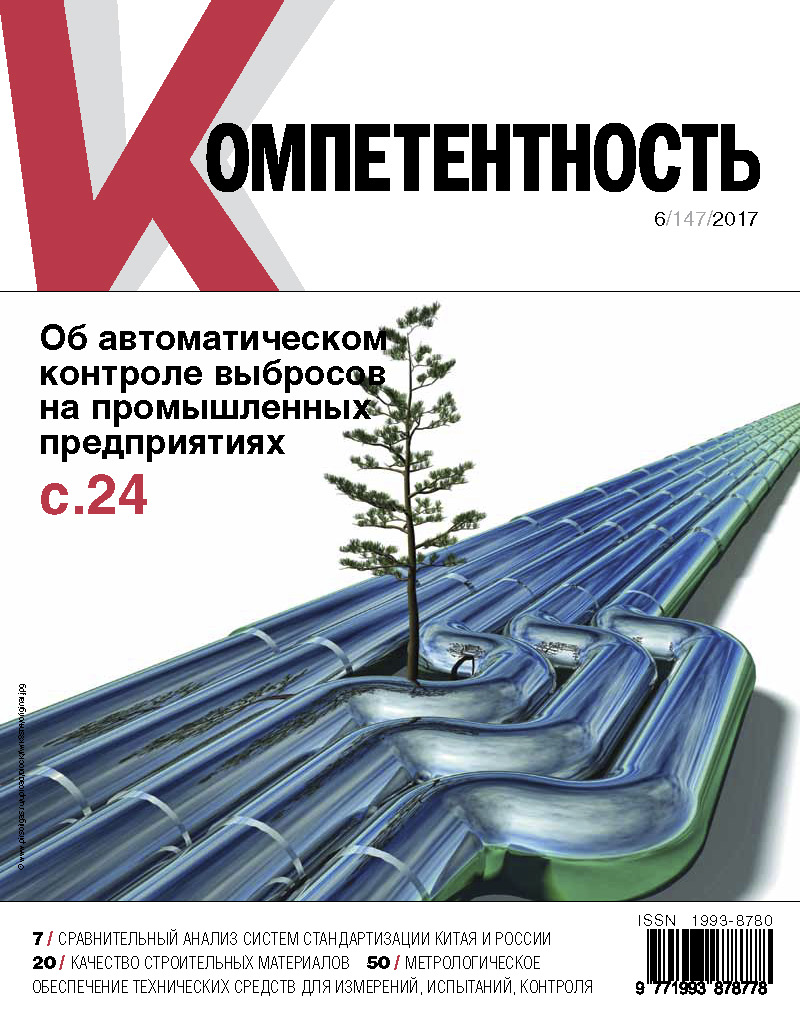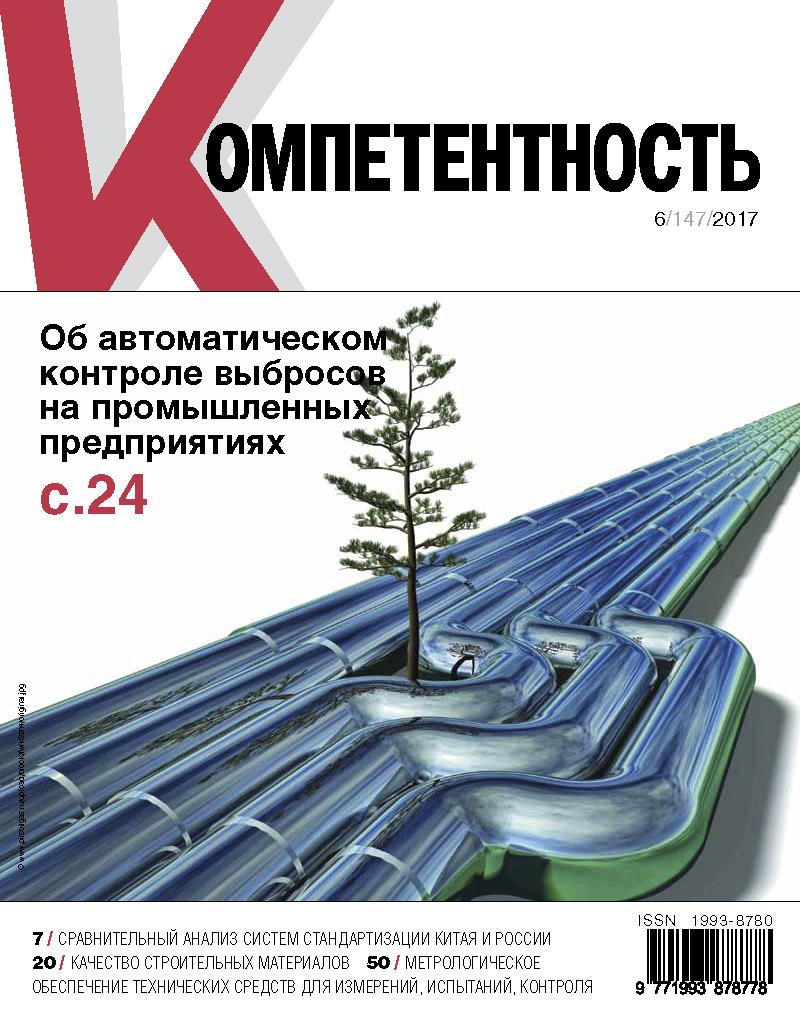Journal Kompetentnost': 6 / 147 / 2017
Articles
-
1
Actualization of Normative Documents in the Field of Technical Regulation
Authors: Dr. Zh.V. Ovadykova, Associate Professor, Department of Metrology, Standardization and Certification, Ukhta State Technical University, Ukhta, Russia, zhanna_ovadykova@mail.ruDr. Т.А. Novosel’tseva, Associate Professor, Gubkin Russian State University of Oil and Gas (National Research University), Scientific and Educational Center Quality, Moscow, Russia, tan-mq@mail.ru We consider that the timely updating of the regulatory documents used at enterprises
We consider that the timely updating of the regulatory documents used at enterprises
contributes to the quality products production.
We have reviewed one of the methods for updating the normative documents
included in the List of National Standards and Codes of Rules (or their parts),
as a result of which the following requirements are enforced on a mandatory basis:
(a) The Federal Law Technical Regulations on the Safety of Buildings and
Structures;
(b) The list of standards, as a result of which voluntary compliance with the
requirements of the Customs Union Technical Regulations On the safety of machinery
and equipment is provided.
As a result, we have proposed an algorithm for updating normative documents
on the basis of electronic resources of federal executive bodies.
Download -
2
Comparative Analysis of National Standardization System of China and Russia
Authors: Van Shennаn’, Heilongjiang Scientific Standardization Institute Center for Study Chinese and Russian Standards of Heilongjiang Province, Heilongjiang Province, ChinaKhan’ Dan’, Heilongjiang Scientific Standardization Institute Center for Study Chinese and Russian Standards of Heilongjiang Province, Heilongjiang Province, China Comparing Chinese and Russian national standardization systems we have analyzed
Comparing Chinese and Russian national standardization systems we have analyzed
the Chinese development program and the Russian concept, as well as other documents
in the field of standardization. While comparing the key areas of Chinese and Russian
standardization systems, it turned out that there are 27 key areas in the Russian
concept, 24 of them coincide with the spheres of the Chinese program.
We have also seen an identical approach to building programs of Chinese and
Russian standardization systems. Both programs agree that standardization is a key
factor in supporting social and economic development and strengthening state power.
They explain in general and in details the directions of development, goals and key
areas that are common.
In the study, we have identified common directions and objectives, as well as
differences in the two countries important industries’ standardization. Thus, having
similar standardization systems, China and Russia will be able to exchange their
experience and take advantage of mutually beneficial advice to achieve the goals of
economic development.
Download -
3
One View of Quality. Confirmation of Compliance Construction and Road-building Materials
Authors: L.А. Bondar’, President, Association NP Association for Technical Regulation (NP Astr), Moscow, RussiaО.V. Lemeshev, Building Materials Conformity Expert, Quality Assurance Center, Moscow, Russia We have considered the questions connected with confirmation of compliance
We have considered the questions connected with confirmation of compliance
of construction and road-building materials which were produced and are produced
at enterprises of Russia and the countries of the Customs Union.
We have also touched upon the interaction of normative and legal acts of the Russian
Federation and the Customs Union, which determine the requirements for the quality
of these materials and the methods for confirming the quality.
We have given a brief analysis for using various construction and road-building
materials in the main industries of Russia. We have evaluated the gained experience
between the manufacturers of this product and the quality assurance authorities
and testing laboratories.
Download -
4
Perspectives for Quipping Industrial Enterprises with Automatic Emission Control Systems
Authors: E.V. Nikitich, Deputy Director (Technical Policy), State Budgetary Environmental Institute Mosecomonitoring, Moscow, Russia, NikitichEV@eco.mos.ruM.Yu. Misyurev, Chief Metrologist (Metrology and Quality Control Sector), State Budgetary Environmental Institute Mosecomonitoring, Moscow, Russia, MisyurevMY@eco.mos.ruDr. Ya.P. Molchanova, Associate Professor, Management and Marketing Department, Dmitry Mendeleev University of Chemical Technology of Russia, Expert of Russian-German Project Climate Neutral Economic Activities: Implementing Best Available Techniques in the Russian Federation, Moscow, Russia, yanamolchanova@yandex.ru We consider challenges of the implementation of new environmental legislation in the
We consider challenges of the implementation of new environmental legislation in the
field of equipping stationary emission sources with continuous monitoring systems.
Key industrial enterprises of major sectors categorized as installations causing adverse
environmental impacts have to install such systems in the near future. We suggest that
current problems deal not only with technical aspects of measurements but very much
by gaps in and shortcomings of the Russian Federation legislative acts, norms and
standards setting requirements in the area.
Download -
5
Innovative Technologies as Part of the Lean Medical Service
Authors: Dr. L.А. Fedyk, Head, Voluntary Certification System All Russian Register, Tumen’, Russia, info@9000-2001.ruDr. G.N. Shestakova, Doctor-organizer of Health, Higher Сategory, Head Physician, Surgut Region Clinical HospitalA.S. Tkachenko, Doctor-metodist, Higher Category, Head, Department of Standardization and Safety Medical Activity, Surgut Region Clinical HospitalYu.V. Ivkina, Expert on QMS Сertification, Voluntary Certification System All Russian Register We have devoted this article to certification to the principles of lean production,
We have devoted this article to certification to the principles of lean production,
which is necessary for every medical center. This procedure guarantees patients
receiving qualified medical care. We have examined the implementation of the basic
principles, methods and tools of lean production on the example of the Surgut Region
Clinical Hospital. We are the first in the Khanty-Mansiysk Autonomous Region —
Ugra who realizes the Lean Region concept. The structure and the plan of measures
(road map) for the implementation of the concept were approved in August 2016 by
the order of our region government. We are confident that the basic organizational
values of lean production are maximum customer orientation, security, increased
value of medical services, reduction of losses and respect for human beings. It will
allow us to raise the quality of health services and to achieve even greater satisfaction
for our patients.
Download -
6
Developing an Integrated Management System of Enterprise for Compliance with QMS Standards and Lean Production
Authors: Assoc. Prof. Dr. V.D. Mogilevets, Consultant, JSC INTERSKOL-Alabuga, Design and Technology of Machine-Building Production Department, Naberezhnye Chelny Branch, FSBEI, A.N. Tupolev Kazan National Research Technical University — KAI, Kazan’, Republic of Tatarstan, Russia, mogilevec-val@mail.ruAssoc. Prof. Dr. I.A. Savin, Head, Design and Technology of Machine-Building Production Department, Naberezhnye Chelny Branch, FSBEI, A.N. Tupolev Kazan National Research Technical University — KAI, Kazan’, Republic of Tatarstan, Russia We have shown that lean production helps organizations to improve their
We have shown that lean production helps organizations to improve their
competitiveness and business performance. Its application assumes a certain way of
thinking, considers any activity in terms of value for the consumer and reduces all
types of losses. According to lean production the enterprise management system was
developed, implemented and certified for compliance with the requirements of GOST
R 56404-2015 at JSC INTERSKOL-Alabuga, which produces professional power
tools. It includes the concepts of quality management system and lean production
management system. After releasing the new version of standards ISO series 9000, the
enterprise management system was integrated to meet the requirements of GOST R
ISO 9001–2015. Personal projects of process optimization managers have helped to
improve the flow of creating value for the electric drill manufacture: (a) in 1,5 times
increased output per one collector of power tools; (b) the total time of the network
electric drill production decreased by 56,6%.
According to the results of the Enterprise Management System self-assessment,
the maturity level from 96 points (37%) increased to 197 points (76%) and reached
the fifth level recognition of the of the lean production management system perfection.
Integration with the health and safety management system will become the next
stage in the development of the Enterprise Management System.
Download -
7
Conceptual Aspects of Lean Production of Goods and Services
Authors: Assoc. Prof. Dr. V.V. Glushchenko, Professor, Department, Management and Personnel Management of the Organization, Emperor Nicholas II Moscow State University of Railway Engineering, Moscow, Russia, glu-valery@yandex.ruAssoc. Prof. Dr. I.I. Glushchenko, Professor, Financial Accounting and Statistics Department, Russian State Social University, Moscow, Russia, prepodavatel-gii@mail.ru Crisis management tendencies analysis allows to draw a conclusion on actual of lean
Crisis management tendencies analysis allows to draw a conclusion on actual of lean
production introduction in all new fields of activity. Therefore, the concept and
content of conceptual approach to lean production of commercial and noncommercial
spheres needs to further improvement. Thus, we have investigated functions, roles and
structural elements of conceptual approach to lean production and have formed the
general theory of lean production.
Lean production is a subject of article. The purpose of article is development
of conceptual approach to lean production (the theory of thrift). For achievement
of this goals we have solved problems:
(a) carrying out search and the analysis of publications on a subject of the theory
and anti-recessionary application of lean production for confirmation of relevance
of the research presented in the present article;
(b) formations and descriptions of an object, method, functions, roles, laws
of the scientific theory of lean production;
(c) investigations anti-recessionary opportunities and the directions of development
of conceptual approach to lean production of goods and services.
Scientific novelty of article is defined by formation and a research of conceptual
approach to lean production, a research and the description of structural elements
of the lean production theory, structuring risks of formation and introduction
of the this concept.
Download -
8
Metrological Provision of Technical Means for Measurement, Testing and Control
Authors: Dr. V.G. Kutyaykin, Head of Department Standardization, Certification and Quality Management, ASMS Nizhny Novgorod Branch, Nizhny Novgorod, Russia, asms-nn@mail.ru The amendments to the Federal Law «On Ensuring the Unity of Measurements»,
The amendments to the Federal Law «On Ensuring the Unity of Measurements»,
a number of new legal and regulatory documents, as well as the existing production
practice, required clarification of certain provisions of the proposed classification
of technical means and forms of their conformity assessment. We have examined
the issues of classification and the forms of assessing the conformity of technical means
for measurements, testing, control based on legal and regulatory acts in the field
of ensuring the uniformity of measurements. We have described in detail the results
documentation and the performers.
At present, there is ambiguity in interpretating the issue of identificating the
document, accompanying the results of admission control systems’ verification.
We believe that the Measurement Report can become such document, or other
forms of documenting the results of the verification system verification, approved
by the company: a journal, a form, electronic files. GOST R 8.884-2015 uses the concept
of «certification of means of admission control».
Download



